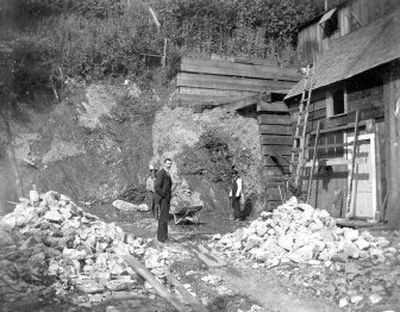Through it all, no one lost Hope

The bustling town of Hope, Idaho, on Lake Pend Oreille caught fire 100 years ago this month; nearly the entire business district went up in smoke.
It was a devastating blow to this picturesque, terraced town, but it wasn’t the first devastating blow. Hope, about 17 miles east of Sandpoint, had already burned several times, including once in 1890 and again in 1900.
The problem, according to local historians Maurice and Ingrid McKay in the book “Beautiful Bonner: The History of Bonner County, Idaho,” was that Hope residents obtained most of their water by troughs from springs above the city; thus the town lacked a pressurized water system. Once a fire started, it was nearly impossible to put out.
This July 15, 1906, fire started from a defective flue in the Hope Hotel-Cafe just after noon. Within hours, the town’s post office, drugstore, barbershop and four saloons had been reduced to embers. The Congregational Church was deliberately blown up with dynamite, in a fruitless attempt to stop the fire from spreading.
Fire wasn’t the town’s only plague. Hope was nearly destroyed in 1894 by a monster storm and accompanying high water.
Still, Hope came back every time. In fact, Hope was far bigger in those days than today. It was an important division point on the Northern Pacific Railroad, with a roundhouse and extensive workshops. It was also a logging town, mining town, fishing town and a popular summer resort.
The earliest residents of the area were the Kalispel Indians, who had a permanent camp nearby for centuries.
Many other tribes converged on the lakeshore every fall for big celebrations and feasts. Nearby Memaloose Island is said to have been an important tribal burying ground.
Then, in 1809, fur trader David Thompson built his Kullyspell House trading post near the site of present-day Hope. The post was abandoned after only a few years.
The town had its true beginnings in 1882 when a Northern Pacific railroad construction camp was established there. Thousands of workers arrived on the lakeshore, including as many as 1,000 Chinese laborers; some ended up staying. The town acquired the name of Hope not because of any surfeit of optimism, but in honor of a veterinarian, Dr. Hope, who treated the horses at the work camp.
The town retained a wide-open Western feel in those days.
“Gambling and drinking were the order of the day until around 1892 when the town was cleaned up by a bunch of enterprising citizens,” wrote pioneer Louise Amblie, whose family arrived in 1890. “At one time there were seven saloons within the distance of one block.”
Another pioneer, Sam Strong, wrote in a memoir that members of a “vigilance committee” once took it upon themselves to hitch a wire cable to a floating disorderly house. Then they hitched the other end of the cable to a switch engine, which built up a head of steam. The ladies fled ashore before the house was smashed to bits.
Hope was also a “sporting” resort of a more respectable kind. Several resort hotels, including the Highland House and the Hotel Jeannot (which survives today as the Hotel Hope), catered to “sports” from back East. Strong recalled that he and his brother used to take “sport tourists” out on fishing and hunting excursions.
By 1903, the place called Hope had a population of around 500. It had two hotels, several restaurants, plenty of saloons and the Twin Woo Co., specializing in Chinese goods.
Even though almost the entire business district of town was destroyed by the 1906 fire, Hope bounced back and remained a popular destination for Northern Pacific travelers and steamboat passengers from Sandpoint. However, the industries that Hope was founded upon – railroads, logging, mining and fishing – went into a slow fade.
Hope’s population is now only about 80, although East Hope, which has grown up just down the lakefront, has about 200 souls.
One industry that is doing just fine: the tourist industry.
Head for Hope in high summer and you’ll find it bustles nearly as much as it did in the old days. The marina is busy and the restaurants are crowded.
It may not be quite as red-hot as it was back in the early days, but this time of year, Hope hops.